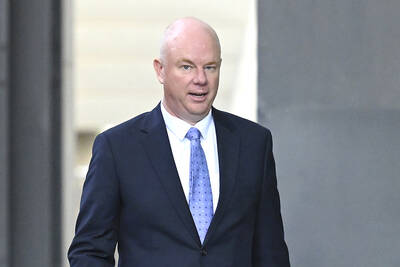If the prospect of spending 1,000 days up to 225 million kilometers away from planet Earth were not enough of a deterrent, you might think the killer radiation levels and enforced radio silence would put off any volunteers to travel to Mars. However, NASA has revealed it is seeing near-record numbers apply for its astronaut training program, as growing hopes of a manned mission to the red planet rekindle enthusiasm for deep space travel.
Since the successful landing of the unmanned Curiosity rover in August last year, the scientific community has begun to take more seriously a promise from US President Barack Obama in 2010 to land humans on the surface within about 20 years.
Some privately backed rival ventures are even forecasting they could get to Mars orbit as early as 2018, and NASA plans a deep space practice mission to rendezvous with a captured asteroid by 2025.
“Interest in sending humans to Mars has never been higher,” NASA’s chief administrator and former astronaut Charles Bolden told a conference in Washington on Monday. “We now stand on the precipice of a second opportunity to press forward with what I think is man’s destiny and that is to go forward to another planet.”
Within the next few weeks, NASA plans to announce which 20 new trainee astronauts it has chosen from 6,300 recent candidates — its second-highest application total since the agency was established in 1958.
“These astronauts will be among the first trained specifically for long-duration space flights,” Bolden said.
Despite sweeping US budget cuts, NASA still hopes for an annual budget of US$17.7 billion — increasingly targeted on the Mars mission as the top priority. It is seeking Congressional approval to outsource to private contractors all future rocket missions to low Earth orbit, so it can concentrate on deep space instead.
However, the three-day conference in Washington has also revealed how significant the remaining “technology gaps” are.
The one-tonne Curiosity rover was lowered to the surface of Mars from a spacecraft acting at current weight limits as a “sky crane,” yet engineers estimate a human capsule would need to weigh at least 40 times as much. NASA also needs to invent giant new solar panels — powerful enough to complete a round trip to Mars, but flexible enough to fold up into a rocket — and find ways of preventing the craft from being damaged by charged ions.
At least five unmanned supply missions will need to deliver equipment in advance and a robotic vehicle will probably drill beneath the surface to look for water for drinking and propulsion of the return trip.
The sun is likely to block communication for weeks on end and robots will probably also need to be used to help build a shelter on the surface of Mars to protect astronauts from cosmic radiation 100 times that on Earth.
Pascale Ehrenfreund, a scientist at NASA’s astrobiology institute, warned that its projections for a 1,000-day mission, including a stay of a few hundred days on the surface, currently showed an “unacceptable risk” of radiation exposure.
Notwithstanding its attempts to learn how to steer asteroids, NASA sees the Mars mission as a vital stepping stone into outer space for humanity in the long run.
“We know from looking at what happened when an asteroid hit Earth 65 million years ago that single-planet species tend not to survive,” science director John Grunsfeld said.

Nauru has started selling passports to fund climate action, but is so far struggling to attract new citizens to the low-lying, largely barren island in the Pacific Ocean. Nauru, one of the world’s smallest nations, has a novel plan to fund its fight against climate change by selling so-called “Golden Passports.” Selling for US$105,000 each, Nauru plans to drum up more than US$5 million in the first year of the “climate resilience citizenship” program. Almost six months after the scheme opened in February, Nauru has so far approved just six applications — covering two families and four individuals. Despite the slow start —

MOGAMI-CLASS FRIGATES: The deal is a ‘big step toward elevating national security cooperation with Australia, which is our special strategic partner,’ a Japanese official said Australia is to upgrade its navy with 11 Mogami-class frigates built by Japan’s Mitsubishi Heavy Industries, Australian Minister for Defence Richard Marles said yesterday. Billed as Japan’s biggest defense export deal since World War II, Australia is to pay US$6 billion over the next 10 years to acquire the fleet of stealth frigates. Australia is in the midst of a major military restructure, bolstering its navy with long-range firepower in an effort to deter China. It is striving to expand its fleet of major warships from 11 to 26 over the next decade. “This is clearly the biggest defense-industry agreement that has ever

North Korean troops have started removing propaganda loudspeakers used to blare unsettling noises along the border, South Korea’s military said on Saturday, days after Seoul’s new administration dismantled ones on its side of the frontier. The two countries had already halted propaganda broadcasts along the demilitarized zone, Seoul’s military said in June after the election of South Korean President Lee Jae-myung, who is seeking to ease tensions with Pyongyang. The South Korean Ministry of National Defense on Monday last week said it had begun removing loudspeakers from its side of the border as “a practical measure aimed at helping ease

DEADLY TASTE TEST: Erin Patterson tried to kill her estranged husband three times, police said in one of the major claims not heard during her initial trial Australia’s recently convicted mushroom murderer also tried to poison her husband with bolognese pasta and chicken korma curry, according to testimony aired yesterday after a suppression order lapsed. Home cook Erin Patterson was found guilty last month of murdering her husband’s parents and elderly aunt in 2023, lacing their beef Wellington lunch with lethal death cap mushrooms. A series of potentially damning allegations about Patterson’s behavior in the lead-up to the meal were withheld from the jury to give the mother-of-two a fair trial. Supreme Court Justice Christopher Beale yesterday rejected an application to keep these allegations secret. Patterson tried to kill her